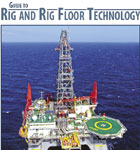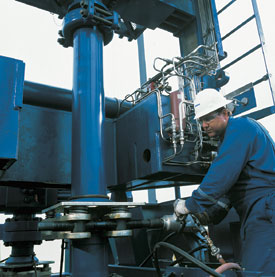Rig floor equipment: Improved deepwater coiled tubing motion compensation
December 2004 Supplement Rig Floor Equipment Improved deepwater coile
Improved deepwater coiled tubing motion compensationSince the search for oil and gas moved offshore, industry has been trying to achieve a high degree of efficiency and increase personnel safety – the move into ever deeper waters has heightened this imperative. Among the first of the resulting new equipment breed is a coiled-tubing (CT) motion compensation system that is delivering safety, efficiency and reliability.
The Schlumberger CT TComp total compensation system emerged from a two-year field study conducted with Shell, including 5,000 hr of operational data from 128 deepwater CT projects in the Gulf of Mexico (GOM). Solutions that emerged are being implemented in the GOM, while operators in other prominent deepwater regions are evaluating the new system. Heave motion offshore makes every task more difficult, and deep water compounds the challenge; and it became apparent that each platform type had its own distinct set of motion compensation problems. CT TComp can be used as a motion-compensated jacking frame, a 350-t tension lift frame, or an internally compensated tension-lift frame. Jacking frame mode – The TLP platform has two major challenges. If work outside the derrick can be performed safely, CT operations can occur simultaneously with platform rig operations. With a standard heave-compensated jacking frame, the wellhead moved each time a connection was broken. The second challenge is lateral wellhead movement, which is addressed with a titanium flex joint. The new frame can be positioned over large well-bay slots or across skid beams on spar platforms, distributing the CT load over the platform deck. The frame mast, which stands 63 ft high, allows 35 ft of tools to be assembled within the frame. A riser-centering device in the base works with the titanium flex joint to bring the riser into alignment on TLP platforms. Money associated with installing a block compensator is saved; and gooseneck loads are not transmitted to the riser and connections. Tension-lift frame – When used as a 350-t tension-lift frame, the CT TComp system transmits riser load from the blocks around the CT equipment, reducing time and risks to install the equipment. Prior to this, all CT equipment had to be installed after the frame was raised into the derrick and hung from the blocks. The new system’s frame can be assembled into the derrick in either one or two pieces, depending on rig capacity. Internally-compensated tension-lift frame – Spar platforms also pose two concerns; once the spars are removed, no structure exists to perform well maintenance and, as spar platforms do not usually have compensated blocks, rigging up for CT projects can be difficult. The new system utilizes the rig skid beams, if they are left in place, and compensates internally for vertical heave. During rig-up, the driller is required to monitor block load and adjust for wellhead motion throughout the entire CT operation, which can last several days. To alleviate human error, the internally compensated frame provides a relatively constant wellhead load. Safety as a built-in aspect of the new compensation system is critical. The operator is provided with firm work platforms placed at standard break points. And four fall arrestors follow the operator so that both hands can be used while climbing. A folding gooseneck unfolds hydraulically, and use of a stabbing unit to pull CT into the injector reduces worker exposure to precarious heights, awkward positions and CT backlash. Such new-generation system enhancements offer operators a better value equation. With the advent of designs like this with built-in ultimate benefits of safety, efficiency and reliability, the wish list for compensation in deep water just got shorter. |
|||||||||
- Coiled tubing drilling’s role in the energy transition (March 2024)
- Advancing offshore decarbonization through electrification of FPSOs (March 2024)
- Subsea technology- Corrosion monitoring: From failure to success (February 2024)
- Using data to create new completion efficiencies (February 2024)
- Digital tool kit enhances real-time decision-making to improve drilling efficiency and performance (February 2024)
- E&P outside the U.S. maintains a disciplined pace (February 2024)




